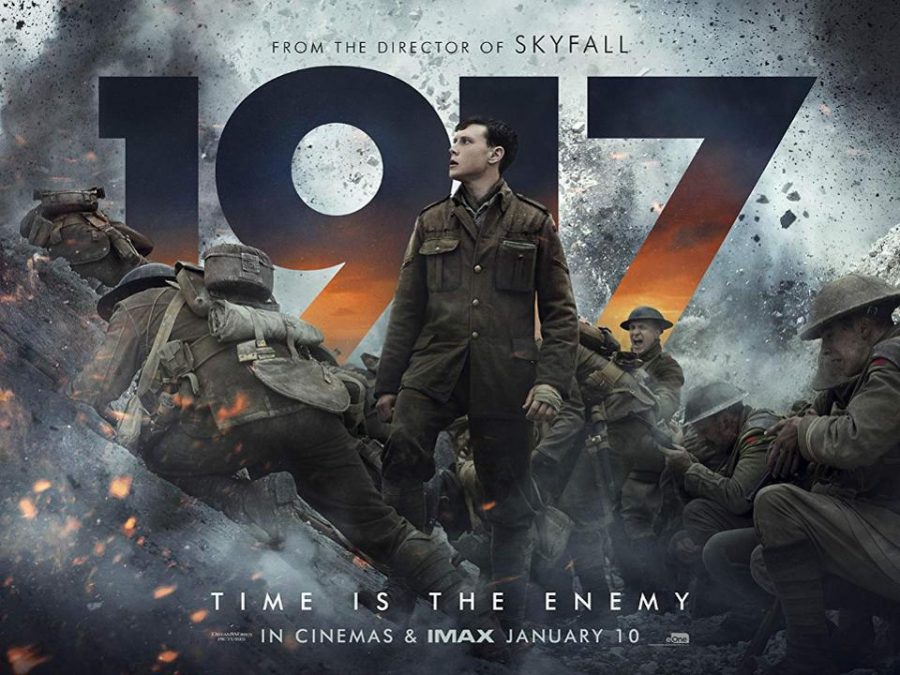‘1917’ creates cinematic beauty out of war
March 10, 2020
At the 2020 Golden Globes, acclaimed director of “Skyfall” and “American Beauty,” Sam Mendes, won two awards for his new film 1917, so new during one of his acceptance speeches he announced its wide release was coming the following week.
“1917” won two Golden Globes for Best Director, and Best Picture, and has won more at other award ceremonies such as BAFTA.
Many famous directors have tried their shot at war films, and succeeded. Francis Ford Coppola’s Apocalypse Now, Steven Spielberg’s Saving Private Ryan, Christopher Nolan’s Dunkirk, and Stanley Kubrick’s Full Metal Jacket, are few that come to mind.
None of them quiet felt as emotional and gut wrenching as “1917.” Before seeing the film, my favorite films dealing with war were Deer Hunter, and Dunkirk.
Deer Hunter grips its viewers with great acting and an emotional storyline. While Dunkirk’s visuals and choreography are stunning. The two selling points for those films are extremely present in 1917.
One of the most mesmerizing motifs about the film, is the way director Sam Mendes, and cinematographer Roger Deakins make the film appear like it is taken in one single shot.
The famous one shot technique used in other films such as Alejandro Gonzalez Inarritu’s 2014 Best Picture winner “Birdman” or Alfred Hitchcock’s “Rope.” It encapsulates the tense nature of the film, and it also allows for some innovative and beautiful shots.
In an interview with Vox, Mendes said he chose to direct the film in one continuous take because, “I wanted to tell the story in two hours of “real time”. So I felt like it was a natural thing, to lock the audience into the men’s experiences.”
The film makes its viewers feel as if they are along the mission with the two main characters, Lance Corporal Blake (played by Dean-Charles Chapman) and Lance Corporal Schofield (played by George MacKay). Time and pressure dangingly above the two.
Unlike other war movies Apocalypse Now and Saving Private Ryan, who had astonishing performances by actors in the likes of Marlon Brando and Tom Hanks, “1917’s” two leading men do not steal the show or have a groundbreaking performance.
This being the cause of the film is not heavy in dialogue, it is centered and the physical actions of the characters. Both men outside of their characters they play are relatively unknown in the world outside of the U.K.
Another thing that will persuade viewers to go and watch “1917,” is the fact that it is a World War I story. Many war films are about World War II and the Vietnam War. The story being based off of Sam Mendes’ grandfather’s stories from war.
The story centers around Schofield and Blake on a mission ordered by General Erinmore (played by Colin Firth) to inform the Second Battalion to call off the attack will soon ensue tomorrow morning, or else over 1,000 men will die, including Blake’s older brother.
It is quite unusual for director’s to write their own films but in this case it pays off. Mendes uses his own family’s experience to create a historical fiction story.
My personal favorite scene in the film, is when Schofield wakes up in an abandoned building after being grazed by a bullet, he walks out and numerous flares lighting and setting a backdrop for the scene. He dodges the obstacles against him, and eventually finds sanctuary for a short while.
While watching this scene for the first time, my eyes watered at the artistry and allure of the scene.
Another stunning scene is when Schofield is in a river and struggles between the tough waves, afterwards he stumbles in the forest and finds a large group of English soldiers singing the 19th century American folk song, Wayfaring Stranger.
Not all the scenes in the movie were as intensely emotional and powerful as those two. Some of the most memorable moments are jokes or stories Schofield and Blake share.
The two wandered around a field of wildflowers and Blake tells a memory of his mother and older brother planting crops and flowers for their garden, something that is hinted at again towards the end of the film.
The amount of effort and detail that was put into this film by every member, from the cast, to the editors is remarkable and apparent.
Whether it be everyone in one scene getting the choreography to a T, or Thomas Newman’s fitting and appealing score.
“1917,” is not just a film about war, it is a film about the emotional and physical deterioration that can happen to a man in war, it is a thriller, it is a beautiful piece of cinema.
“1917” was nominated for 10 awards from Best Sound Editing to Best Picture. It ended up rightfully taking home, Best Cinematography, Best Sound Mixing, and Best Visual Effects.


